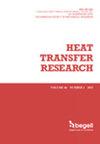Research of Triangular Baffle Placement Effect on the Heat Transfer and Flow Features in Cross-Triangular Grooved Triangular Channels
IF 1.6
4区 工程技术
Q3 THERMODYNAMICS
引用次数: 0
Abstract
In this study, heat transfer performance and fluid flow properties for cross-circular grooved triangular ducts having different location angles and heights of the triangular baffles are numerically searched. The program of Ansys-Fluent is applied to find out the equations of energy and Navier Stokes by employing the turbulence model of k-ε in computational calculations. While the temperature of the inlet of air working fluid is 293 K, values of the wall surface temperature of the lower circular grooved channel are taken as constant 373 K. Triangular baffles have different angles of 30o, 60o and 90o and heights of 0.25H, 0.5H and 0.75H. The range of the Reynolds number employed in this study is 1000-6000. Numerical results agreed with a 3.53% deviation according to empirical work that existed in technical literature. The attained outcomes are presented as mean Nu number, fluid temperature, turbulence kinetic energy, pressure and Performance Evaluation Criterion (PEC) number variations for each triangle baffle angle and height. Distributions of the contour of the temperature, velocity, turbulence kinetic energy and vector of velocity are also evaluated for distinct Re numbers and triangle baffle arrangements. For Re=3000, the Num number in the channel with a 90o baffle angle and 0.75H height is 136.73% higher than that in the channel with 0.25H height, and in the 0.25H baffle height channel, the PEC number is 91.91% higher in the 30o baffle angle condition than in the 90o.三角挡板放置对交叉三角槽三角通道传热和流动特性的影响研究
在这项研究中,对具有不同位置角和高度的三角形挡板的交叉圆形槽形风道的传热性能和流体流动特性进行了数值搜索。计算中采用 k-ε 湍流模型,应用 Ansys-Fluent 程序求出能量方程和纳维-斯托克斯方程。空气工作流体的入口温度为 293 K,下部圆形凹槽的壁面温度恒定为 373 K。本研究采用的雷诺数范围为 1000-6000。数值结果与技术文献中的经验结果一致,偏差为 3.53%。获得的结果显示为每个三角障板角度和高度下的平均努数、流体温度、湍流动能、压力和性能评估标准(PEC)数变化。此外,还评估了不同 Re 数和三角障板布置下的温度、速度、湍流动能和速度矢量的轮廓分布。当 Re=3000 时,90o 挡板角和 0.75H 高度通道中的 Num 数比 0.25H 高度通道中的 Num 数高 136.73%,而在 0.25H 挡板高度通道中,30o 挡板角条件下的 PEC 数比 90o 挡板角条件下的 PEC 数高 91.91%。
本文章由计算机程序翻译,如有差异,请以英文原文为准。
求助全文
约1分钟内获得全文
求助全文
来源期刊

Heat Transfer Research
工程技术-热力学
CiteScore
3.10
自引率
23.50%
发文量
102
审稿时长
13.2 months
期刊介绍:
Heat Transfer Research (ISSN1064-2285) presents archived theoretical, applied, and experimental papers selected globally. Selected papers from technical conference proceedings and academic laboratory reports are also published. Papers are selected and reviewed by a group of expert associate editors, guided by a distinguished advisory board, and represent the best of current work in the field. Heat Transfer Research is published under an exclusive license to Begell House, Inc., in full compliance with the International Copyright Convention. Subjects covered in Heat Transfer Research encompass the entire field of heat transfer and relevant areas of fluid dynamics, including conduction, convection and radiation, phase change phenomena including boiling and solidification, heat exchanger design and testing, heat transfer in nuclear reactors, mass transfer, geothermal heat recovery, multi-scale heat transfer, heat and mass transfer in alternative energy systems, and thermophysical properties of materials.
 求助内容:
求助内容: 应助结果提醒方式:
应助结果提醒方式:


